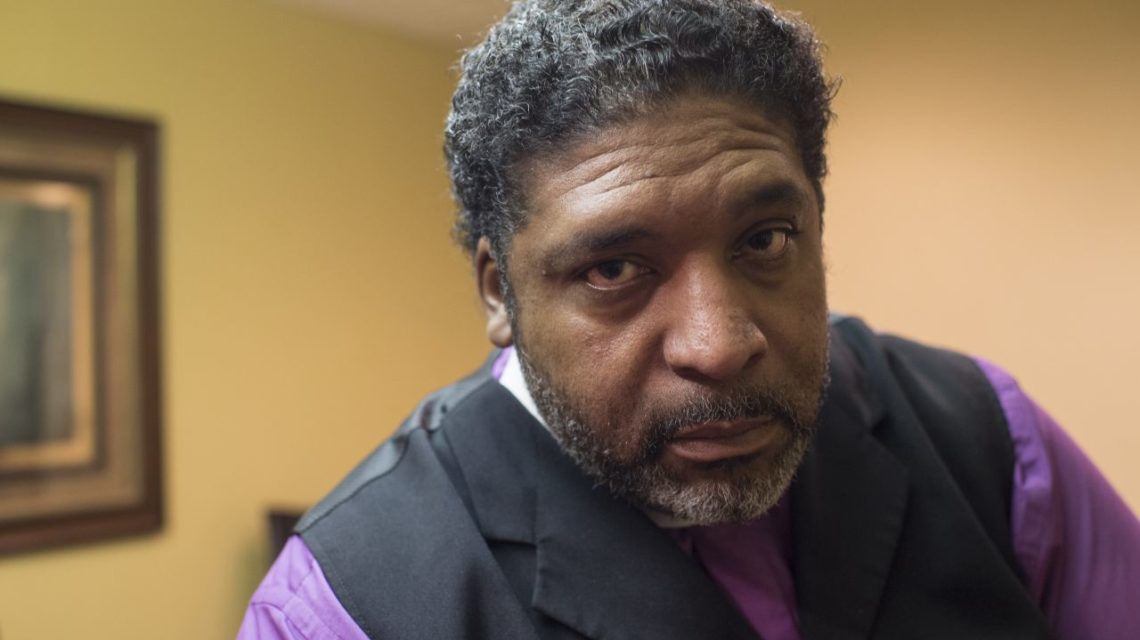By Amanda Abrams
BillMoyers.com, August 21, 2017 —
Rev. William Barber is joining other religious and activist leaders to launch a new Poor People’s Campaign, picking up where Martin Luther King Jr. left off.

North Carolina NAACP President, Reverend William Barber, poses for a portrait in Raleigh, North Carolina, on Thursday, January 21, 2016. (Photo by Nikki Kahn/The Washington Post via Getty Images)
[This post first appeared at Yes! Magazine.]
In 1968, Martin Luther King Jr. and his allies started the Poor People’s Campaign, a movement meant to improve the lives of low-income Americans. But King was assassinated a few months before its political actions officially kicked off, and the campaign never reached its full potential.
Fifty years later, Rev. William Barber, head of the North Carolina NAACP, is joining other religious and activist leaders to launch a new Poor People’s Campaign, picking up where King left off. Although King is universally associated with civil rights and the struggles of African Americans, the original Poor People’s Campaign was an inclusive effort to alleviate the poverty of Americans of all races. And today’s organizers say that goal is fundamental to the new campaign as well.
In this deeply polarized sociopolitical climate, the message is an attractive one, emphasizing not left or right, but a collective moral obligation to allow everyone a fair shot at a decent life.
Barber’s inclusive language certainly succeeded in North Carolina, where the popular Moral Mondays protests he spearheaded in 2013–14 helped elect a Democratic governor last year. But for the new movement to gain national traction, it will need to appeal not only to African Americans and progressive whites, who currently make up Barber’s base, but also draw in poor and working-class whites, too.
And that’s the tricky part.
These days, two things are clear: Race played a key role in the election of President Trump, and there are still deep veins of racism in this country. Low-income whites — those without college degrees — overwhelmingly supported Trump. Will they have any interest in joining a movement largely populated by blacks, even if it’s in their best self-interest?

Demonstrators participating in the Poor People’s March at Lafayette Park and on Connecticut Avenue, Washington, D.C., on June 18, 1968. Photo from Library of Congress.
“At the center is the idea of uniting poor people across racial and geographic lines,” says Rev. Liz Theoharis, co-chair of the Poor People’s Campaign. The group plans to hold six weeks of civil disobedience and direct action next spring in more than 25 states and Washington, DC. Until then, it’s in organizing mode, working with coalitions across the country that represent lower-income people, groups like Fight for $15 and the Vermont Workers’ Center.
There’s no shortage of potential members. The campaign isn’t just focused on folks in grinding poverty; it’s targeting people who are a couple of paychecks away from being poor — roughly a third of the population, according to the latest census. In real numbers, that group includes far more white people than any other race.
But bringing them into a diverse coalition won’t be simple. “If it was easy, we’d already be there,” says Ben Speight, an organizer with the Teamsters in Atlanta who grew up in a poor Georgia county. “My experience has been that the conversation around race and racism, the internal divides among workers, has always been a part of what we’re doing.”
To some degree, that divide has been manufactured by people in power. For instance, it was the key element of the “Southern strategy” that Republicans used to win the South in the 1960s and ’70s.
According to Barber, the legacy of those policies is the place to start. “We have to begin by refusing the labels that have been used to divide us,” he says. “The key to helping poor white people see through the lie is to show them how the politicians who play to their racial fears actually hurt them the most.” The states that have passed laws to restrict African Americans’ access to the polls also have the highest levels of white poverty, he explained.
Barber continued: “So we’re actively recruiting the same people the white nationalists are recruiting. We’re saying to the young men who went to Charlottesville to rally, ‘You’ve been conned. If you want better wages and opportunity for your family, immigrants aren’t the problem. Black people aren’t the problem. Liberals aren’t the problem. Corporate greed and traditional left-right politics are the problem.’ And the only way America has ever challenged this structure is for poor people to unite across the dividing lines in a moral movement to revive the heart of democracy.”
Much has been written about the diversity of North Carolina’s Moral Mondays movement, which arose in opposition to the state government’s sudden lurch to the right in 2010. Yet even it failed to attract poor white people. “It was largely progressive whites” who got involved, says Thomas Mills, who runs the PoliticsNC blog.
There were some exceptions. In Belhaven, North Carolina, veteran organizer Bob Zellner — a former civil rights activist whom Moral Mondays organizers persuaded to join the movement because of his deep experience bringing together disparate groups — worked with local white Republicans to try to save the area’s rural hospital from closing. As a Moral Mondays representative, he held workshops in Belhaven to encourage the majority-white group to advocate for keeping the hospital open, and twice walked to DC with the town’s mayor for the cause.
“They needed help wherever they could get it. That gave us an opening to work with them,” Zellner says. Having a specific issue made all the difference.
“To reach poor and working-class whites, you can’t appeal to them on the basis of doing the right thing. You have to appeal to them to link [together] with their black brothers and sisters on the basis of getting something you both need,” he [Zellner] says.
The effort ultimately failed. Because North Carolina didn’t expand Medicaid under the Affordable Care Act, the hospital couldn’t afford to stay open. Yet the struggle nonetheless bore fruit. Zellner still works with many of those townspeople today, largely as a result of the trust that was gradually built by working together toward a common goal. That’s key, Zellner says. “It’s incremental and slow, not based on the electoral cycle. People want to see that you’re sincere.”
The Moral Mondays campaign likely also had some legitimacy with lower-income whites, many of whom were churchgoers, because it was led by a minister and rooted in Christian principles. “Rather than dismiss people’s faith, we’ve tried to engage it,” says Jonathan Wilson-Hartgrove, a minister in Durham and one of the architects of the Moral Mondays protests. “You have to go to the text: What does the Bible actually say about the poor and the government’s responsibility to do justice? I think people do respond to the simple integrity of that message.”
Veteran organizers agree that working across races in the South, with its history of racial prejudice, is more difficult than elsewhere and that the Moral Mondays movement might not be an ideal model for how the Poor People’s Campaign can bring low-income whites into a movement dominated by blacks. Experts agree that organizing low-income people across races is hard everywhere, however.
Karen Nussbaum and Matt Morrison are co-directors of Working America, an affiliate of the AFL-CIO that has been reaching out to working-class communities for 14 years, knocking on thousands of doors every week. It’s not affiliated with the Poor People’s Campaign but is “very much in line with what they’re doing,” Nussbaum says.
Nussbaum and Morrison agree that the best way to organize low-income whites is through one-on-one discussions, as slow as that technique may be.
One of the big issues is that the people they encounter often don’t have enough accurate information. “We find that it’s enormously successful to start a conversation about what are their concerns and what’s the cause of those concerns. And we talk about ‘Maybe it’s not your neighbors, maybe it’s not immigrants who are threatening your economic future, but the corporate and Wall Street influence,’” Nussbaum says. “That’s a message that resonates very strongly with the people we talk to.”
Morrison adds that many low-income whites are open to a very progressive agenda, once they learn more about it. “We’ve seen that the difference in how urgently people think a $15 minimum wage is needed doesn’t depend on race but on income,” he says.
In the end, the biggest potential challenge for the new Poor People’s Campaign might not be figuring out how to bring whites and blacks closer together. The greatest issue, as Morrison and many others have acknowledged, will likely be getting poor people, particularly whites, to become involved at all.
“It’s the nature of American politics: The most votes are among the poorest people, but the poorest people [typically] don’t vote. Their participation rates are abysmal,” says Seth McKee, a professor of political science at Texas Tech University. “That makes [organizing low-income people] really hard.”
But it’s a goal worth working for. After all, an energized army of low-income people of all ethnicities would be a mighty force.
Amanda Abrams is a freelance journalist based in Durham, North Carolina.












